Teleonemia Costa, 1864
Type species: Teleonemia funerea Costa
Species within Teleonemia are highly variable morphologically.
Body narrow and elongate, head short, clypeus not surpassing apical half of first antennal segment; antennal length variable, shorter than or as long as pronotumpronotum:
dorsal sclerite of the first thoracic segment
; cephalic spinescephalic spines:
a spine on the head
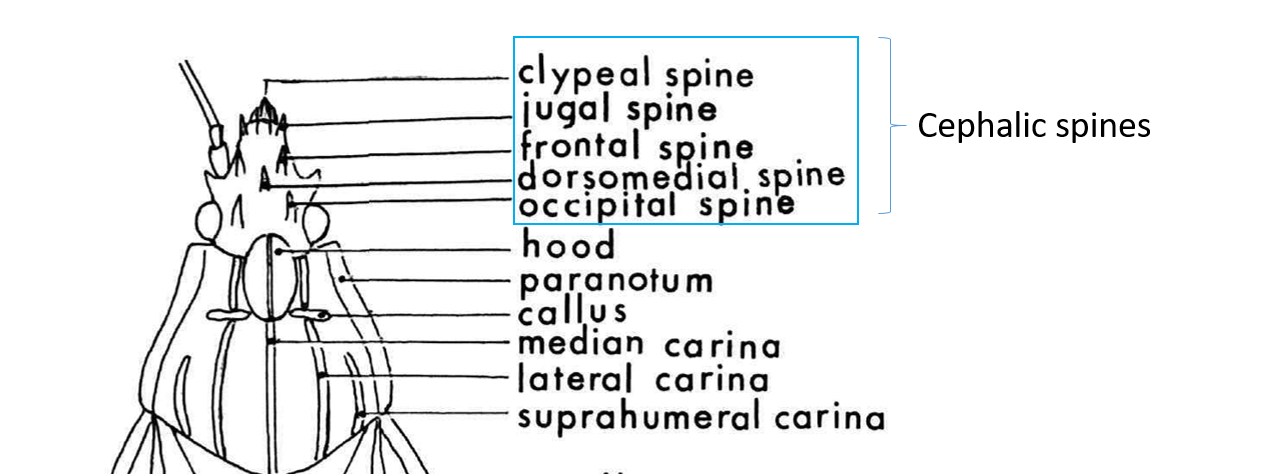 present; bucculaebucculae:
present; bucculaebucculae:
an elevated ridge on either side of the first labial segment
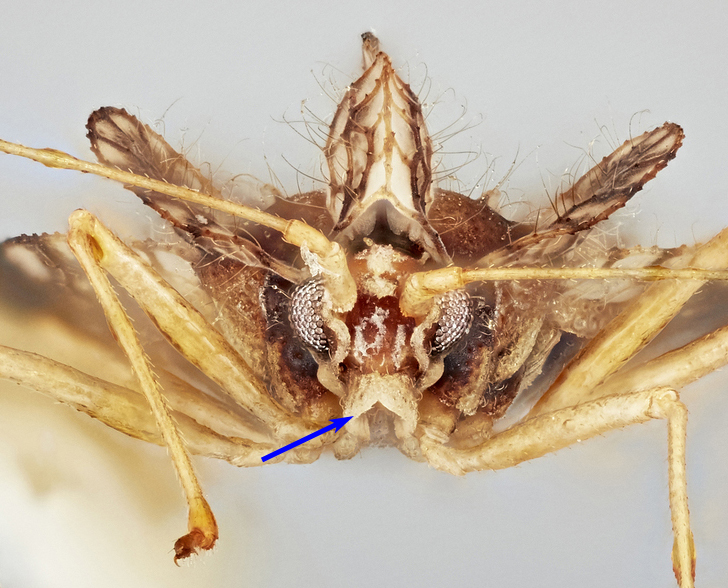 open or closed anteriorly; rostral sulcusrostral sulcus:
open or closed anteriorly; rostral sulcusrostral sulcus:
shallow furrow on either side of rostrum (labium)
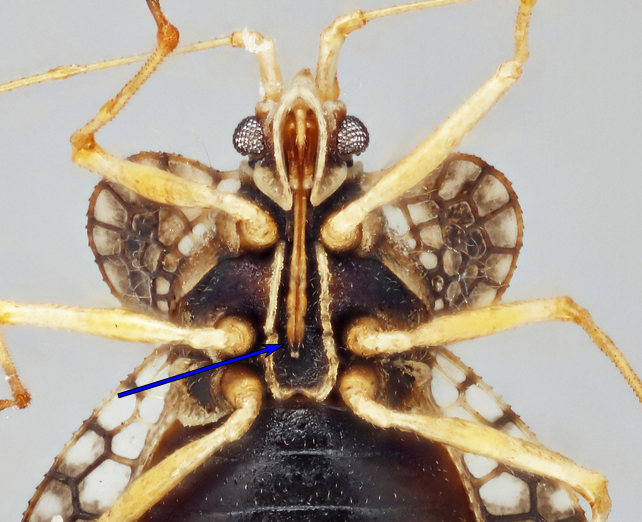 uninterrupted by a transverse carinacarina:
uninterrupted by a transverse carinacarina:
elevated ridge or keel
, cordate-shaped on metasternum; pronotumpronotum:
dorsal sclerite of the first thoracic segment
tricarinate, height of median carinacarina:
elevated ridge or keel
equal to height of lateral carinae; pronotal hoodhood:
term used to describe the modified anterior area of the pronotum, which is sometimes tectiform and sometimes bulbous, with numerous intermediate conditions.
 present or absent; if present, not bulbous and not extending forward beyond the apex of head; paranotumparanotum:
present or absent; if present, not bulbous and not extending forward beyond the apex of head; paranotumparanotum:
lateral extension of pronotum; may be carinate, explanate, or reflexed
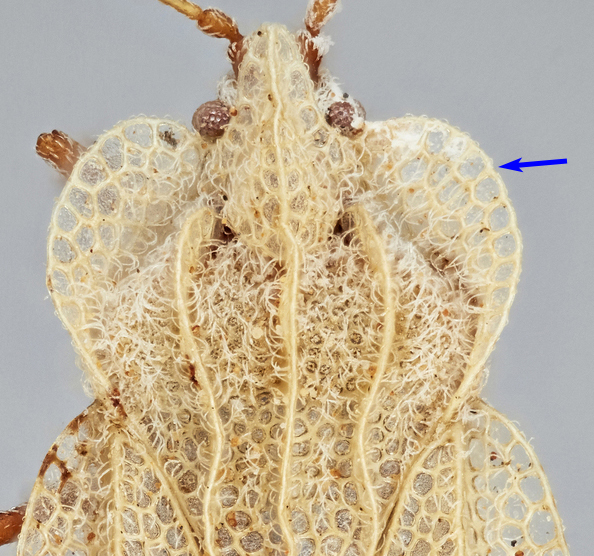 obsolete or uniseriateuniseriate:
obsolete or uniseriateuniseriate:
arranged in a single row, as in uniseriate areolae
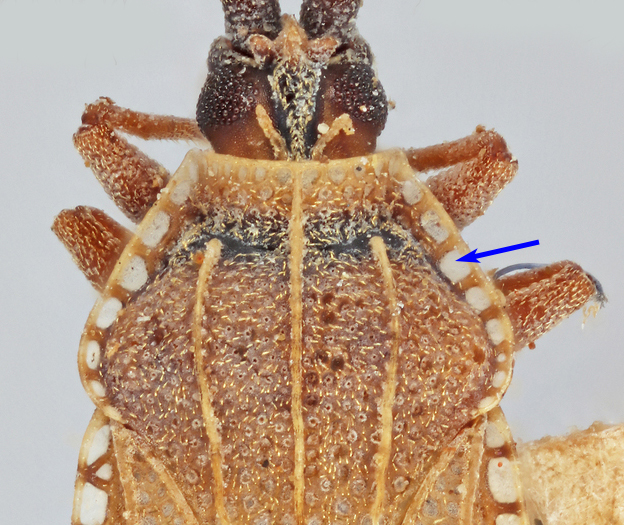 ; if uniseriateuniseriate:
; if uniseriateuniseriate:
arranged in a single row, as in uniseriate areolae
 , reflexedreflexed:
, reflexedreflexed:
bent or curved backwards, as in a reflexed paranotum
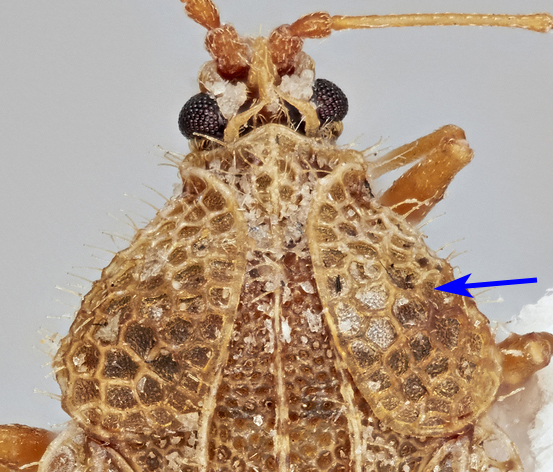 and appressed to the pronotal disc, spines absent along paranotal margin, anterior margin not projecting anterad or pointed slightly, not reaching near the apex of head; hemelytrahemelytra:
and appressed to the pronotal disc, spines absent along paranotal margin, anterior margin not projecting anterad or pointed slightly, not reaching near the apex of head; hemelytrahemelytra:
one of the basally thickened forewings of Hemiptera
with claval areaclaval area:
parallel-sided and sharply pointed anal area of hemelytron
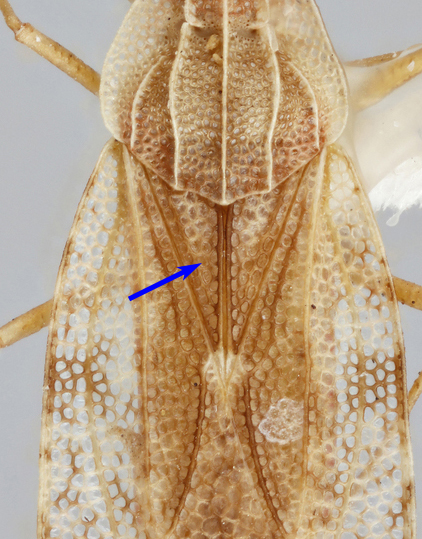 weakly developed, almost entirely covered by posterior margin of pronotumpronotum:
weakly developed, almost entirely covered by posterior margin of pronotumpronotum:
dorsal sclerite of the first thoracic segment
; discoidal areadiscoidal area:
area of the forewing posterior to the subcostal area
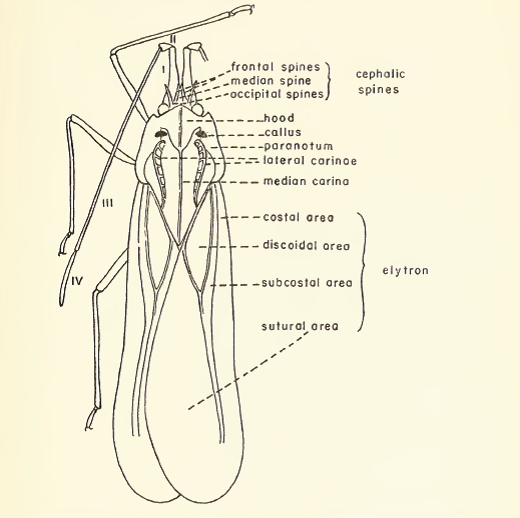 level, discoidal cell extending slightly beyond the middle of hemelytrahemelytra:
level, discoidal cell extending slightly beyond the middle of hemelytrahemelytra:
one of the basally thickened forewings of Hemiptera
(Hurd 1946Hurd 1946:
Hurd, M. E. P. 1946. Generic classification of North American Tingoidea (Hemiptera-Heteroptera). The Iowa State College Journal of Science 20: 429-493., Knudson 2018Knudson 2018:
Knudson, A. H. 2018. The Tingidae (Hemiptera: Heteroptera) of southern Central America (with an emphasis on Costa Rica). Master#39;s thesis. North Dakota University. https://library.ndsu.edu/ir/handle/10365/28773, Guidoti et al. 2015Guidoti et al. 2015:
Guidoti, M., S. I. Montemayor , and Eacute;. Guilbert. 2015. Lace bugs (Tingidae). In A. R. Panizzi and J. Grazia (eds.), True bugs (Heteroptera) of the Neotropics. Springer Netherlands.).
Afrotropical, Australasian, Nearctic, Neotropical, Oriental (Drake and Ruhoff 1960Drake and Ruhoff 1960:
Drake, C. J., and F. Ruhoff, A. 1960. Lace-bug genera of the world (Hemiptera: Tingidae). Proceedings of the United States National Museum 112., Drake and Ruhoff 1965Drake and Ruhoff 1965:
Drake, C. J., and F. A. Ruhoff. 1965. Lacebugs of the World: A Catalog (Hemiptera: Tingidae) Bulletin of the United States National Museum: 1ndash;634., Guilbert 2019Guilbert 2019:
Guilbert, E. 2019. Lace bugs database - http://www.hemiptera-databases.com/tingidae)
| Intercepted species | Shipment origin(s) | Inspected host(s) |
|---|---|---|
| Teleonemia nigrina Champion | France, Mexico | Brassica sp., Helianthus sp., household goods |
| Teleonemia prolixa (Stål) | Haiti, Jamaica, Mexico | Helianthus annuus, Helianthus sp. |
| Teleonemica sacchari (Fabricus) | Argentina, Dominican Republic, Jamaica | Aloysia citrodora, Rosamarinus officinalis |
| Teleonemia scrupulosa Stål | Australia, Colombia, Costa Rica, Dominican Republic, El Salvador, Grenada, Guatemala, Guyana, Haiti, Hawaii, Honduras, Jamaica, Kenya, Mexico, Panama, Trinidad and Tobago, United States of America | Amaranthus sp., Ananas sp., Anigozanthos sp., Artemisia dracunculus, Brassica oleracea, Dendrobium sp., Erythrina berteroana, Eucalyptus sp., Lantana sp., Lippia sp., Mentha sp., Mentha spicata, Momordica sp., Ocimum basilicum, Ocimum sp., Origanum vulgare, Psidium guajava, Rosmarinus officinalis, Rosamrinus sp, Salvia sp., Scholtzia sp., Thymus sp., Thymus vulgaris, Vigna sp. |
| Teleonemia sp. | Belize, Dominican Republic, Ecuador, El Salvador, Haiti, Jamaica, Mexico, Netherlands, Nigeria, Peru, St. Kitts and Nevis, St. Lucia, Tortola, Trinidad and Robago, Uruguay, US Virgin Islands | Abelmoschus esculentus, Allium sp., Amaranthus sp., Daucus sp., Erythrina sp., Eucalyptus sp., Fragaria sp., Helianthus sp., Lantana sp., Leucospermum sp., Lippia sp., Melissa officinalis, Mentha sp., Momoridca charantia, Ocimum basilicum, Opuntia sp., Origanum vulgare, Pimenta sp., Rudbeckia sp., Salvia officinalis, Salvia sp., Thymelaea hirsuta, Thymus sp. |
Drake and Ruhoff 1960Drake and Ruhoff 1960:
Drake, C. J., and F. Ruhoff, A. 1960. Lace-bug genera of the world (Hemiptera: Tingidae). Proceedings of the United States National Museum 112., Drake and Ruhoff 1965Drake and Ruhoff 1965:
Drake, C. J., and F. A. Ruhoff. 1965. Lacebugs of the World: A Catalog (Hemiptera: Tingidae) Bulletin of the United States National Museum: 1ndash;634., Guidoti et al. 2015Guidoti et al. 2015:
Guidoti, M., S. I. Montemayor , and Eacute;. Guilbert. 2015. Lace bugs (Tingidae). In A. R. Panizzi and J. Grazia (eds.), True bugs (Heteroptera) of the Neotropics. Springer Netherlands., Guilbert 2019Guilbert 2019:
Guilbert, E. 2019. Lace bugs database - http://www.hemiptera-databases.com/tingidae, Hurd 1946Hurd 1946:
Hurd, M. E. P. 1946. Generic classification of North American Tingoidea (Hemiptera-Heteroptera). The Iowa State College Journal of Science 20: 429-493., Knudson 2018Knudson 2018:
Knudson, A. H. 2018. The Tingidae (Hemiptera: Heteroptera) of southern Central America (with an emphasis on Costa Rica). Master#39;s thesis. North Dakota University. https://library.ndsu.edu/ir/handle/10365/28773